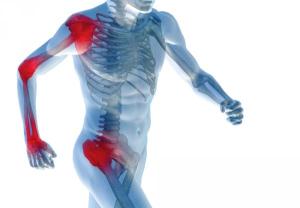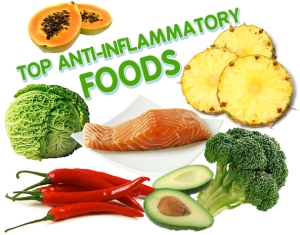Inflammation is truly one of the greatest scourges of our times. From heart disease and other chronic illness to everyday aches and pains, the body’s response to external stress can make or break anyone. The manifestations of inflammation may or may not be obvious as it’s a process that yes, is often displayed through various outward indicators like swelling and redness, but what about what’s going on on the inside? If it’s troubling to look at the ill-effects of surface inflammation, do we even want to know what it looks like inside the body?
Before we get much further, I believe it important to bring a little of my own history to the forefront. Why exactly is a big muscle bound Powerlifter preaching about the dangers of environmental stressors  like poor food choices, chronic stress, and injury? The answer is simple, I am more than meets the eye. My area of focus at Michigan State University was focused on public health, bio-ethics, and anthropology. As such, I have a deep awareness of the impacts of societal systems in the role of individual health. We are after all, all part of the same complex interconnections of family, work, and life. Our individual decisions impact the system as a whole and this same complex system impacts the individual as well. For the benefit of ourselves as well as being proactive in establishing more sustainable means of health care we must value our own individual agency in all that we do.
like poor food choices, chronic stress, and injury? The answer is simple, I am more than meets the eye. My area of focus at Michigan State University was focused on public health, bio-ethics, and anthropology. As such, I have a deep awareness of the impacts of societal systems in the role of individual health. We are after all, all part of the same complex interconnections of family, work, and life. Our individual decisions impact the system as a whole and this same complex system impacts the individual as well. For the benefit of ourselves as well as being proactive in establishing more sustainable means of health care we must value our own individual agency in all that we do.
The beauty in all of this is that my role as a trainer allows me to bring relevant information to the front lines of the battle for quality life outcomes. To me, being able to enjoy a sense of well being and dignity in making positive choices for yourself is instrumental in progressing toward real solutions for an overburden American health care system. We either begin to fix this now in a proactive manner on our own terms or pay the price of being subject to the demands of others. If you do not make a decision to actively pursue a healthy existence then you are effectively relegating your own agency to some one else to decide. So it begs the question, who really knows what’s best for you? I hope the answer is obvious and I hope the following information helps you progress along in a long, happy, and healthy life!
With that done, what exactly is inflammation, what does it do, and why does it happen? We are about to get a little scientific here so strap in and enjoy the ride! I promise though, the information is easy to understand and the knowledge you will gain will be relevant to making positive changes in your own life.
So first, what is inflammation? As it turns out, inflammation is your body’s natural response to threats from germs, harmful toxins, environmental pollutants, injury and stress, and others. The process involves immune, vascular, and cellular biochemical reactions which work to remove the offenders and protect tissues from damage.[1] With that, what are these responses more specifically? As it turns out, when inflammation occurs, chemicals such as inflammatory cytokines are released into the blood or tissues as part of the healing response. Inflammatory cytokines are destructive to our normal cells and with chronic inflammation they result in irritation and wearing down of cartilage and tissues, and lead to

So why is our body doing this to us? The answer is quite simple and presented in what was previously stated. Your body is trying to protect itself from stress and injury. To be more direct, your body is trying to protect itself from your choices. Work, relationships, sickness, bad food choices, smoking, sedentary physical habits and ensuing weight burdens all take a toll on the body. It’s true that stress on some level is inevitable but what if you could reverse some of this process and take control of the cycle and pull out of a nose dive? Well, you can.
To do this we need to tackle one major culprit that has a bunch of associated implications. Bad eating. Eating crappy processed foods is a recipe for disaster. Research has shown this, as has common sense and anecdotal evidence. On the fancy science end of the spectrum we’ve known for quite some time that stress and resulting inflammation is immunosuppressive and puts you at risk for both acute and chronic sickness, but what we are also beginning to see paints an even more clear picture. Recent discoveries, notably of the hormones leptin and adiponectin, have revised the notion that adipocytes are simply a storage depot for body energy. Instead, adipocytes are also endocrine organs, with multiple metabolic roles in regulating whole-body physiology. Small adipocytes in lean individuals promote metabolic homeostasis; the enlarged adipocytes of obese individuals recruit macrophages and promote inflammation and the release of a range of factors that predispose toward insulin resistance. Exercise activates the AMP-activated protein kinase (AMPK) in muscle and other tissues, a pathway that increases fat oxidation and glucose transport. Importantly, the adipocyte hormones leptin and adiponectin also activate AMPK; remarkably, the same pathway is activated by certain antidiabetic agents such as thiazolidinediones.[2] Wait, what? Simply stated, adipocytes are better known as their role in adipose tissue. As previously mentioned in super science section above, it tends to break down into a couple of different versions. To make it straight forward, the healthy lean people mentioned at the start carry more of the smaller adipocytes that actually utilize hormonal systems to burn fat for energy and not store it in bulk. The second option is the case of overweight and obese individuals carrying around larger stores of the larger adipocytes that actually inhibit fat burning and create a hormonal system that breeds scenarios like Type II Diabetes. What these two versions are though in more common terminology is fat cells; namely brown and white fat cells.[3]
To cut right to it, white fat is the big fat cells that do awful things and the brown fat is more readily used for energy and not fat storage. So, going all the way back to the beginning, fat and inflammation are a destructive force destroying lives around the world. With this in mind, the idea is to bring some very simplistic changes to the diet to support anti-inflammatory actions in the body and are also painless to include in your everyday eating. Diets fail, but dietary consistency can and should be done. Finding foods you enjoy that taste good, provide a great nutritional profile, and are not going to put you at risk for caloric surplus is the primary concern with this initial introduction to anti-inflammatory foods. With 

The idea with a daily anti-inflammatory score is to reach a daily score of 50 or more points. A great tool to utilize and aid you in scoring out your foods is to visit nutritiondata.self.com to get a clear scoring outline of thousands of foods. As you’ll find, some common foods actually score negatively on the inflammatory score thus a balance must be struck to come out above 50 points per day. A piece of pizza for instance carries a (-123 )score. It’s when putting the pieces together that it becomes evident just how vital proper food intake can be in maintaining a healthy internal environment and the role of dietary impacts. The 3 fruits I’ve included can go a long way in helping you maintain a positive balance in your day. They taste great, are easy to find, and can make a powerful addition to keeping yourself free of dietary stressors. We all battle enough with inevitable stress, pick up some of these sweet options to combat inflammation and satisfy cravings, all while getting an impressive array of vitamins, minerals, and valuable phytonutrients.
1. Pineapple : Anti-Inflammatory Score: 65
http://nutritiondata.self.com/facts/fruits-and-fruit-juices/2019/2
2. Kiwifruit : Anti-Inflammatory Score: 34
http://nutritiondata.self.com/facts/fruits-and-fruit-juices/1934/2
3. Strawberries: Anti-Inflammatory Score: 28
http://nutritiondata.self.com/facts/fruits-and-fruit-juices/2064/2
[1] Eliaz, Dr. Isaac . “Doctor Speaks on Impact of Chronic Inflammation.” News Medical Journal. 17 Feb 2011: n. page. Web. 14 Jan. 2014. <http://www.news-medical.net/news/20110217/Doctor-speaks-on-health-effects-of-chronic-inflammation.aspx>.
Obesity and the role of adipose tissue in inflammation and metabolism
Am J Clin Nutr February 2006 83: 461S-465S
[3] Brown Fat, White Fat, Good Fat, Bad Fat
Posted on March 26, 2013 by Dr. Francis Collins




